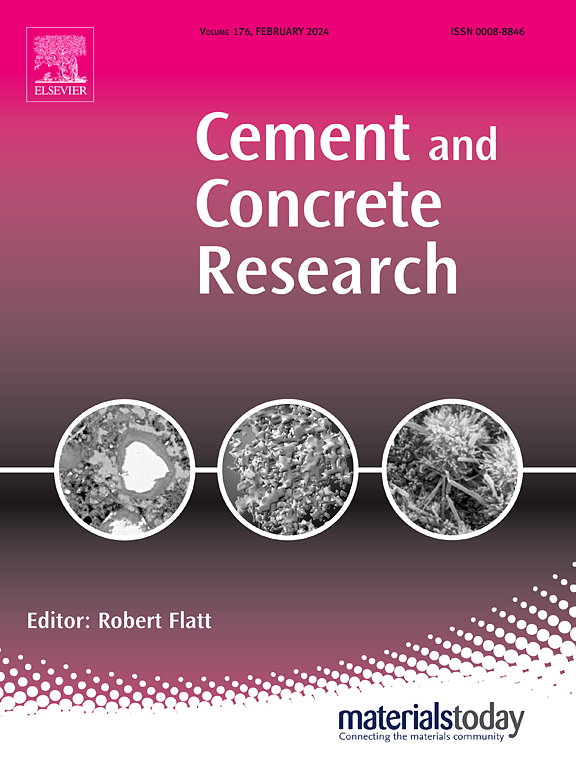Phase assemblages of seawater-mixed model cement modified by in-situ polymerization
IF 13.1
1区 工程技术
Q1 CONSTRUCTION & BUILDING TECHNOLOGY
引用次数: 0
Abstract
In-situ polymerization of organic monomers in seawater cement is an effective method to mitigate the erosion of cement hydrates. Understanding the effects of in-situ polymerization on the hydration products of model cement holds promise for extending the service life of seawater concrete. Herein, we conducted a series of experiments combined with Density Functional Theory (DFT) calculations to investigate the impact of in-situ polymerization of sodium acrylate (SA) on the phase assemblages of seawater-mixed model cement. Our findings reveal that in-situ polymerization of SA enhances the stability of hydration products. This improvement is attributed to the carboxylic acid groups of polyacrylic acid (PAA), which form stable coordination bonds with Ca2+ and Mg2+, anchoring onto the surface of hydration products and weaving an organic-inorganic interpenetrating network structure that strengthens interfacial bonding and inhibits erosion from external ions, thereby reducing calcium dissolution. However, the physical barrier effect of PAA on mineral surfaces and its chemical adsorption behavior towards Ca2+ collectively alter the aqueous chemical environment, thereby inducing nucleation poisoning effects in C-S-H while reducing precipitation rate of other hydrates. Notably, PAA significantly lowers the decalcification risk of the C-S-H structure by enhancing its erosion resistance. These findings are expected to deepen the understanding of the role of in-situ polymerization in cement-based materials and promote the design of durable seawater-mixed concrete.
原位聚合改性海水混合水泥模型的相组合
海水水泥中有机单体的原位聚合是缓解水泥水合物侵蚀的有效方法。了解原位聚合对模型水泥水化产物的影响,有助于延长海水混凝土的使用寿命。在此,我们结合密度泛函理论(DFT)计算进行了一系列实验,研究丙烯酸钠(SA)原位聚合对海水混合模型水泥相组合的影响。我们的研究结果表明,原位聚合的SA提高了水化产物的稳定性。这种改善归功于聚丙烯酸(PAA)的羧基,它与Ca2+和Mg2+形成稳定的配位键,锚定在水化产物的表面,编织一个有机-无机互穿网络结构,加强界面键合,抑制外部离子的侵蚀,从而减少钙的溶解。然而,PAA对矿物表面的物理屏障作用及其对Ca2+的化学吸附行为共同改变了水化学环境,从而在C-S-H中诱发成核中毒效应,同时降低了其他水合物的沉淀速率。值得注意的是,PAA通过增强C-S-H结构的抗侵蚀能力,显著降低了其脱钙风险。这些发现有望加深对原位聚合在水泥基材料中的作用的理解,并促进耐用海水混合混凝土的设计。
本文章由计算机程序翻译,如有差异,请以英文原文为准。
求助全文
约1分钟内获得全文
求助全文
来源期刊

Cement and Concrete Research
工程技术-材料科学:综合
CiteScore
20.90
自引率
12.30%
发文量
318
审稿时长
53 days
期刊介绍:
Cement and Concrete Research is dedicated to publishing top-notch research on the materials science and engineering of cement, cement composites, mortars, concrete, and related materials incorporating cement or other mineral binders. The journal prioritizes reporting significant findings in research on the properties and performance of cementitious materials. It also covers novel experimental techniques, the latest analytical and modeling methods, examination and diagnosis of actual cement and concrete structures, and the exploration of potential improvements in materials.
 求助内容:
求助内容: 应助结果提醒方式:
应助结果提醒方式:


